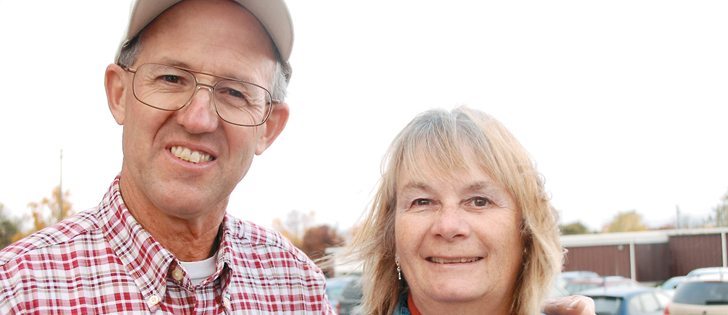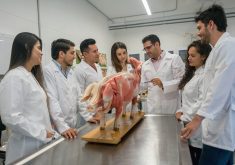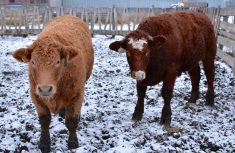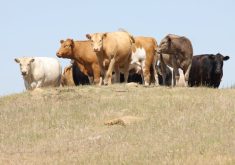Experts visit Canada | American graziers draw on their own experiences as they help other producers get the most from their pastures
ARTHUR, Ont. — The learning curve was steep and nearly fatal when Greg Judy began mob grazing cattle in 1999.
He had the pastureland, the animals and equipment. What he failed to recognize was the need to fully integrate all aspects of his fledgling operation in central Missouri.
“Basically, we were doing everything wrong in 1999. I was very close to going bankrupt,” he said.
“I didn’t focus on what was really important, the forage, the grass … and we were pushing the animals too hard. We lost track of them getting enough energy.”
Read Also

Farming Smarter receives financial boost from Alberta government for potato research
Farming Smarter near Lethbridge got a boost to its research equipment, thanks to the Alberta government’s increase in funding for research associations.
Today, Judy and his wife, Jan, raise cattle on almost 1,600 acres of leased and owned land, including 750 acres of pasture. It’s a rolling area of woodlots and idled farm fields a short drive northwest of Columbia.
Drawing on the mob grazing techniques popularized by South African rancher Ian Mitchell-Innes, Judy views his operation as a kind of web in which various species, from the soil microbes to the cattle, each fill an interactive role.
Success depends on maintaining a healthy soil ecosystem, which in turn provides the foundation for healthy forages and healthy animals, he said.
This requires that the soil remain covered, but Judy also suggests a rotational grazing system in which a substantial amount of trampled forage is left each time the herd is moved. The technique, known as mob grazing, maintains a high animal and acreage population over a short period and improves plant productivity.
“For every grass blade you trample into the ground, you’ll get two back.”
Judy did talk about cattle density, such as 100,000 pounds per acre, but said cattle producers interested in mob grazing should not get caught up in the numbers. Rather, they might start with modest change.
For instance, a farm that’s been pastured as a single unit might be divided into two or four parts as a way to increase forage potential. Similarly, increases in cattle density should come gradually.
Jack Kyle, a grazier specialist with Ontario’s agriculture ministry, heard Judy speak.
“About 99 percent of what you heard today will work in Ontario,” he said. “The one advantage we had here in 2013, we only had two days of over 33 C temperature. And we usually get regular rain.”
July can be sweltering in Missouri, with temperatures exceeding 33 C and little rain falling for days on end. However, the state does enjoy relatively mild winters.
Kyle’s preferred approach to pasture maintenance is similar to what Judy advocates, but pastures may be grazed lower, less trampling is involved and animal density is less.
Kyle said pasture is ready for cattle when it’s about as tall as a two-litre bottle of soda. They should be removed once the pastured is shortened to the height of a two-litre bottle laid on its side.
Mob grazing often advocates taking less grass than that, Judy said.
“When you move your cows, there should be enough forage left in that paddock for one more day,” Judy said. “Remember, we’re in the solar collection business, not the grass killing business.”
Judy claims to be able to build 13 centimetres of soil in just five years, but he said higher plant brix levels, which is a measure of sugar, is a better way to keep track of improved soil health.
“The brix in our grasses are skyrocketing. We’ve measured brix in our clover as high as 22. We started out with brix in our grasses a low as eight,” Judy said.
Other signs of improved soil health are more observational in nature.
One of the more obvious has been the apparent increase in earthworm numbers. Judy said a single earthworm can reproduce up to 1.2 million times in a seven year life span, while a ton of earthworms can produce as much as 100 tonnes of castings in a year.
A return of dung beetles to his property in small but growing numbers also indicates that the soil ecosystem is moving in the right direction. The insects take manure deep into the soil and their presence limits flies’ ability to reproduce.
Yet another sign of improved soil health has been the return of native species, both eastern gamagrass and deep-rooted big bluestem.
Gamagrass, now on 20 to 25 percent of his grassland, tolerates wet conditions. Judy said it’s a top-notch warm season fodder but cannot be successfully stockpiled for winter feeding.
“We didn’t plant it. It just appeared,” he said. “It was probably here 100 years and the seed sat in the soil. When you see these native grasses appear, it should be red flag that you’re doing things right.”
Judy also has measures for animal health. Again, it’s a matter of careful observation.
For example, bawling cattle are a sign that there’s a concern to be addressed. Cattle grazing under the hot wire indicates that it is past time to move them, as is bare soil and the formation of cow paths.
Keeping an eye on body condition is a priority for Judy.
Slick, shiny cattle are an indication that they have been well fed. He also looks for signs of adequate rumen fill by examining his cattle between pastures.
The paralumbar fossa, which is the area in front of the hip bone on the left side of cattle, is the key visual indicator of rumen fill. A depression that can grow to a distinct triangular shape in extreme cases is a sign that they are not getting enough to eat. The area will be flat or even slightly bulged when rumen fill is strong.
Animal genetics are also important to Judy. He raises Southpole cows that his website says are designed to eat grass rather than the typical large-framed animals in many feedlots.
They are of moderate size with the cows weighing no more than 1,200 pounds, which helps reduce compaction issues in wet conditions.
Judy prepares a rib eye steak from every animal slaughtered to ensure good eating quality.
“A lot of us are getting animals to the abattoir too soon,” he said.
“Some people like lean beef. I don’t. I want to see some fat on it.”
Judy also looks to improve his herd by culling animals that are susceptible to such problems as worms. He doesn’t use parasiticides such as Ivomec because he feels they can damage the soil fauna.
Judy supplies minerals, but he’s noticed the requirement has diminished over time.
“About 80 percent of it is excreted. Our mineral intake is down 75 percent because they’re now in the forages,” he said.
Judy’s operation has grown, but he has downsized in another sense. Other than an all-terrain vehicle, he owns no equipment. He focuses solely on growing pasture and buys hay when ice and snow cover makes it necessary.
Profit is a prime motivation for Judy but not the only one. He’s looking to bring lasting improvements to wildlife habitat and water recycling on the properties he leases and owns. To this end, he uses a technique known as pulse grazing, in which large numbers of animals are moved into a woodlot or riparian zone.
“Cattle will destroy riparian zones if you leave them there. We put them in, 250 head, for about 12 hours.”
Woodlots have also been improved, attracting a wider variety of wildlife including “monster bucks” that are prized by hunters in the area.
This was the first time Greg Judy spoke in Canada. His farm website is at www.greenpasturesfarm.net.

















